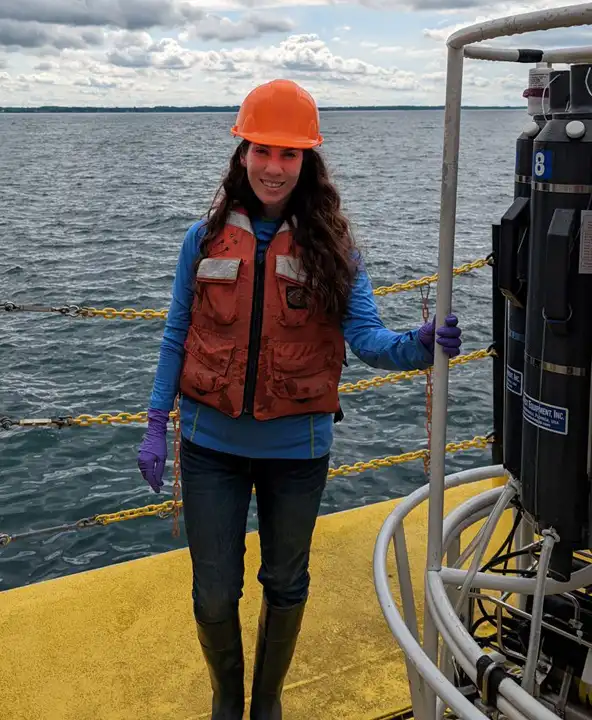Environmental Protection Agency participant monitors the health of the Great Lakes on research vessel
Meet Erica Yang
While Erica Yang has always loved science, she had no idea just how far science would take her. As a child, she recalls deciding she wanted a career doing anything involving nature. After high school she began her academic career as a geologist by graduating with her bachelor’s and master’s in geology from Colby College and State University of New York at Buffalo, respectively. Yang loves the interdisciplinary aspects of geology, particularly the field work, and knew she’d love anything to do with getting outdoors.

Erica Yang’s appointment with the Environmental Protection Agency (EPA) has taken her from geologist to limnologist, where she collects and analyzes nutrient data on the Great Lakes. (Photo Credit: EPA)
After graduation she was a National Park Service intern in Arizona, and then later a physical science technician at Acadia National Park in Maine. While in Maine, Yang became acquainted with limnology, which is the study of lakes. When this seasonal job ended, she was ready for something more.
“I saw the Oak Ridge Institute for Science and Education (ORISE) opportunity on an earth science job board, and I was immediately intrigued! Although I was already familiar with the lake monitoring aspect of the ORISE position, I had only ever done it in the relatively small lakes of Acadia National Park,” said Yang. “I wanted to know what the monitoring would be like on these massive lakes that are essentially the size of small oceans.”
She applied and joined the Environmental Protection Agency’s (EPA) Great Lakes National Program Office (GLNPO), under her mentors Annie Scofield and Matt Pawlowski in the Science, Monitoring, Evaluation and Reporting Section (SMERS).
GLNPO administers seven Great Lakes long-term monitoring programs to assess the health of the Great Lakes. This monitoring satisfies mandates for EPA to monitor and assess the health of the Great Lakes under the Clean Water Act and fulfils the EPA monitoring and ecosystem assessment commitments specified in the Great Lakes Water Quality Agreement and the Great Lakes Restoration Initiative Action Plan.
With GLNPO, Yang is experiencing the vast unknown of the Great Lakes in a way that delights her inner child. While GLNPO monitors all five Great Lakes (Lakes Superior, Huron, Michigan, Erie and Ontario) annually, this year Yang’s field research mainly focused on Lake Ontario. Yang boarded EPA’s Research Vessel Lake Guardian with other scientists, living aboard while the ship visited 30 monitoring stations over four days in support of EPA’s Great Lakes Sediment Surveillance Program (GLSSP). Scientists from EPA, ORISE and the Natural Resources Research Institute of the University of Minnesota Duluth took on 12-hour shifts during this survey. Yang took the 4PM to 4AM shift, assisting with deployment and retrieval of sediment sampling equipment among other things.
However, most days Yang is analyzing data, planning for future monitoring activities and developing her skills in programming. She additionally writes updates about GLNPO programs and activities for the Great Lakes Restoration Initiative website. Her primary research project seeks to summarize and interpret large amounts of particulate nutrients data from the Great Lakes, which have been collected through GLNPO annual monitoring programs since 1997.
“My research can aid us in assessing the overall health of the Great Lakes lower food web. For organisms high on the food chain (e.g., fish) to thrive, a healthy and nutritious lower food web is essential,” explained Yang. “The status of the lower food web not only impacts the fishing industry, but the entire Great Lakes ecosystem as a whole, as the base of the food web provides the energy needed for the survival of all other organisms within that ecosystem.”
Yang plans to submit her research to the Journal of Great Lakes Research, and additionally gave a presentation at the 2023 International Association of Great Lakes Research Conference in Toronto, Ontario on particulate nutrient trends in the Great Lakes.
Collaboration is an extremely important part of her appointment, says Yang, and she’s learned that Great Lakes monitoring is impossible for a single organization to accomplish alone. Collaboration with other federal agencies and academic partners helps SMERS monitor and assess a wide variety of environmental parameters and components of the aquatic ecosystem. As an ORISE participant, Yang is also learning to take an objective, unbiased approach to reviewing raw data, which is a skill useful to all scientists. She feels grateful to be a part of the GLNPO’s SMERS team. Everyone has been supportive, says Yang, and she enjoys meetings with her mentors. Learning from other scientists and researching in the field are her favorite parts so far.
She heartily recommends the GLNPO program to others.
“I have the freedom to pursue research topics that interest me and benefit me. Plus, I still get to do field work, which is great,” said Yang. “At the same time, I am making connections with other scientists and learning from them. This kind of opportunity is extremely rare, and you should absolutely take advantage of it if it’s offered to you.”
After her appointment ends, Yang wants to continue a career in environmental restoration or resource management, particularly involving aquatic ecosystems. Until then, she continues to learn and grow in ways that she never imagined as a child in science class.
The EPA Research Participation Program is administered by the Oak Ridge Institute for Science and Education (ORISE). ORISE is managed for the U.S Department of Energy by Oak Ridge Associated Universities (ORAU).

